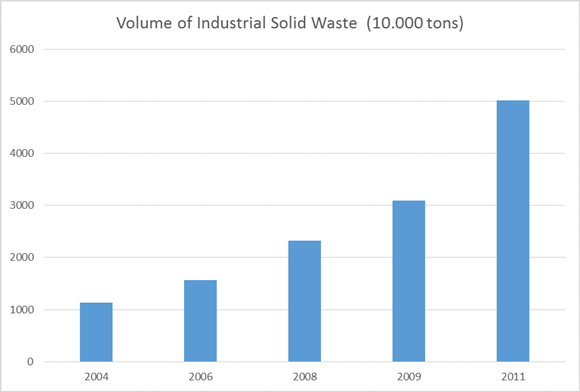 Task Group Materials
Task Group MaterialsOver the last few years, some modern environmentally oriented laws and regulations have come into force in China, which will pave the way for vast changes in the management of undesired materials and also will also free up enormous potential in the field of resource efficency. Examples include the law on Prevention and Control of Environmental Pollution by Solid Waste from April 2005, the Chinese National Catalogue of Hazardous Wastes from August 2008, the Circular Economy Promotion Law from January 2009 and the Law of the People's Republic of China on the Promotion of Cleaner Production from February 2012. In March 2012 the Ministry of Finance and the Chinese National Development and Reform Commission published a statement entitled “Promotion of Circular Economy in Industrial Parks”. By the year 2015, circular economy measures concerning energy and materials will have been implemented in at least 50 % of national industrial parks and 30 % of regional industrial parks. This should contribute to reducing the land use and use of significant resources within the industrial park, through an increase in the recycling of solid waste and the closed cycle of waste water. As concerns the “Zero Emissions”, the emission of certain atmospheric pollutants will also be significantly reduced. These laws will have a significant influence on the development of Midong Industrial Park, the largest planned industrial area in western China, with the newest infrastructure facilities in the field of waste disposal and recycling and also offers a unique window of opportunity for new ideas and developments. An understanding of the working environment and the behaviour of relevant actors and their interests, documented by a study, will help to increase material efficiency through optimised processes and circular economy.
The vigourous pace of development which has taken place in the region of Xinjiang and Urumqi has not only been accompanied by increasing prosperity but also huge environmental problems. The demand for non-renewable raw materials has recently increased, with corresponding consequences on the output side. According to the Xinjiang Statistical Yearbook (2009), ca. 15 million tonnes of solid industrial waste was generated in 2006; in 2008, this figure was 24.4 million tonnes. With an annual increase of over 30 %, the majority was generated in the U-Chang region. The figures for hazardous waste paint a different picture. Here we see a slight decrease in the amount of waste generated, from 640,000 tonnes in 2007 to 600,000 tonnes in 2008. The total amount of industrial waste generate in the period 2008 to 2011, however, has doubled (ca. 50 million tonnes in the Xinjiang region, Xinjiang Statistical Yearbook 2009/2012). The municipal waste generated in Urumqi, which is currently growing at a rate of 30 %, is now estimated at 1.3 million tonnes a year (Xinjiang Statistical Yearbook 2011/2012).

Some figures on industrial waste management in Xinjiang
The vigourous pace of development which has taken place in the region of Xinjiang and Urumqi has not only been accompanied by increasing prosperity but also huge environmental problems. The demand for non-renewable raw materials has recently increased, with corresponding consequences on the output side. According to the Xinjiang Statistical Yearbook (2009), ca. 15 million tonnes of solid industrial waste was generated in 2006; in 2008, this figure was 24.4 million tonnes. With an annual increase of over 30 %, the majority was generated in the U-Chang region. The figures for hazardous waste paint a different picture. Here we see a slight decrease in the amount of waste generated, from 640,000 tonnes in 2007 to 600,000 tonnes in 2008. The total amount of industrial waste generate in the period 2008 to 2011, however, has doubled (ca. 50 million tonnes in the Xinjiang region, Xinjiang Statistical Yearbook 2009/2012). The municipal waste generated in Urumqi, which is currently growing at a rate of 30 %, is now estimated at 1.3 million tonnes a year (Xinjiang Statistical Yearbook 2011/2012).